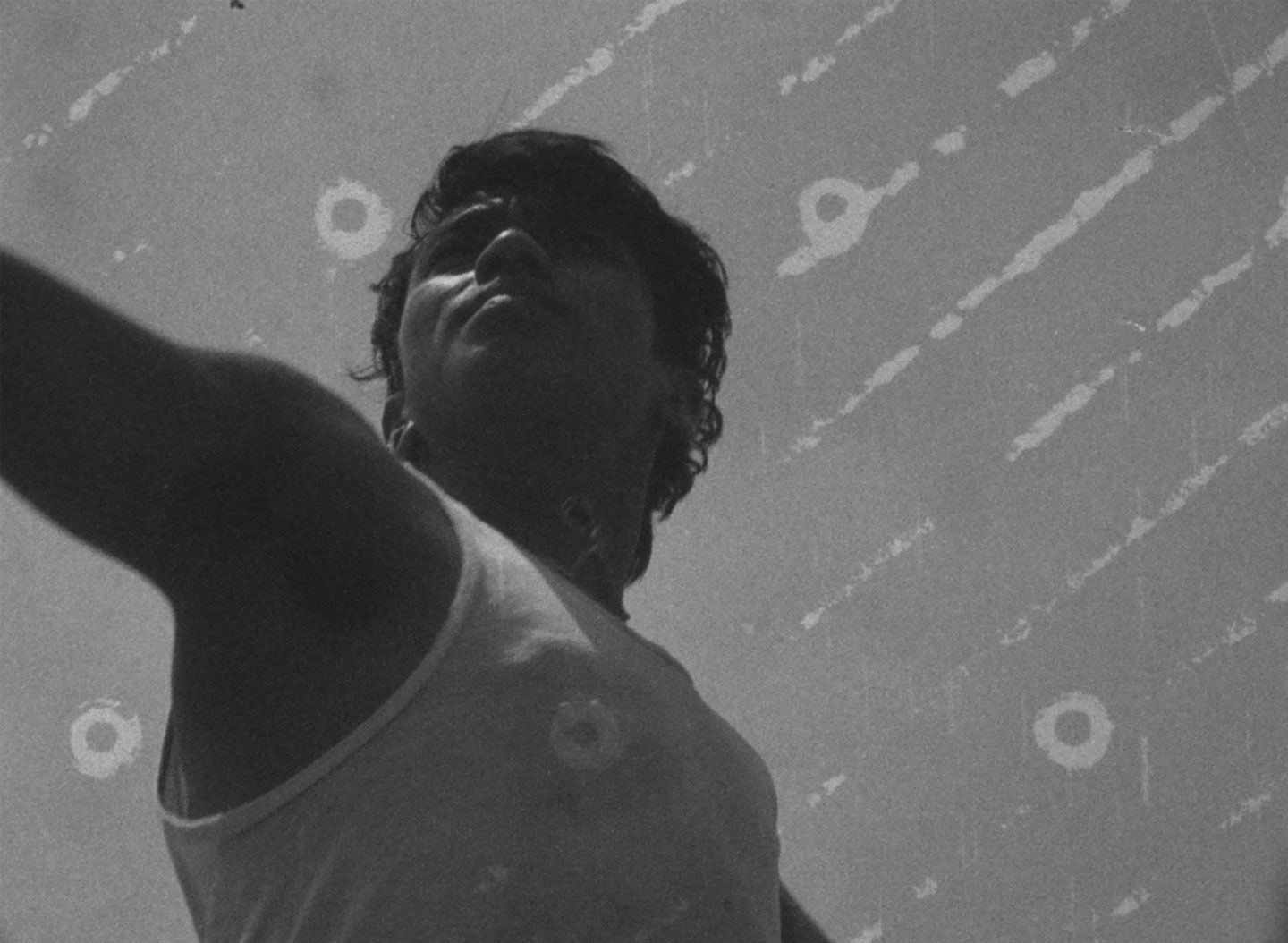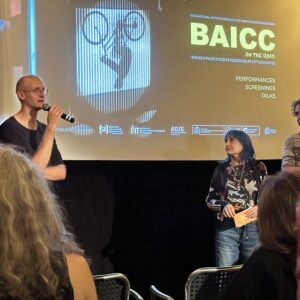By Byron Davies

Has Mexican experimental film come full-circle, found its “secret formula”? In a foundational 1998 exhibition catalog essay for their traveling program Cine Mexperimental, Rita González and Jesse Lerner describe Rubén Gámez’s 1965 baroque anti-gringo filmic poem La fórmula secreta as tracing a critique of twentieth-century discourse about lo mexicano, taking to absurd excess those supposedly Mexican traits (“stoicism, solitude, fatalism”) mined by authors like Octavio Paz and Samuel Ramos. González and Lerner mention the film’s anticipations of Roger Bartra’s 1987 critique of that discourse, as indeed a form of mythmaking expressive of “a powerful nationalist will bound to the unification and institutionalization of the modern capitalist state.”[1]
An impasse thus sets in whenever approaching the concept of “Mexicanness”—a swing between essentializing reductions and remarks on their character as such—which is as pertinent as ever today, at the end of Andrés Manuel López Obrador’s presidential term, characterized by rhetoric of national sovereignty and rejuvenation (“Mexican humanism,” “the Fourth Transformation”) put to progressive ends. It cannot be an accident, then, that there now emerges the most brilliant experimental feature about lo mexicano since Gámez’s La fórmula secreta and Tequila (1992). After all, the “secret” of Annalisa D. Quagliata Blanco’s much-anticipated and rumored-about ¡Aoquic iez in Mexico! / ¡Ya México no existirá más! (Mexico Will No Longer Exist!, in production since 2017, which premiered in June 2024 at the S8 festival in Coruña, Spain, shortly followed by its Mexican premiere at FICUNAM) is to undertake a film about the very ideas of time employed in modern Mexican mythmaking. Here national icons like Quetzalcóatl and the Virgin of Guadalupe circulate in the same wheel of diurnal-nocturnal cycles of the fall and “rebirth” of Mexico City-Tenochtitlán as the “experimental Mexica” rock band Los Cogelones; the Conquista is a daily (indeed, nightly) event in Quagliata’s Mexico City, manifest as deeply as queer sexuality and punk tattoos of the Mexica gods.
Many of Quagliata’s terms for navigating this impasse derive from the rhetoric of the classics of experimental and avant-garde cinema: what P. Adams Sitney regarded as the transition from the “trance” to the “mythopoeic” film is not exactly a dateable historical event, but rather yet another node in a cyclical process of mythmaking. Born in 1990 in the state of Veracruz to Mexican and Italian parents, Quagliata was immersed in the U.S. avant-garde in her education at the Massachusetts College of Art, where until 2015 she studied with Saul Levine and Luther Price; in conversation she has embraced comparisons of certain elements of Aoquic iez with Maya Deren and Gregory Markopoulos. Beyond that, while making the film she was reading the notes and diaries of both Dziga Vertov and Teo Hernández (who himself once imagined a film of Quetzalcóatl and the Virgin of Guadalupe).[2]
At stake in Quagliata’s adoption of “classical” avant-garde rhetoric is how to approach the very idea of “inexistence” invoked in the film’s title, derived from Book Twelve of the 16th-century Florentine Codex, compiled by Friar Bernardino de Sahagún, and recounting how sorcerers sent by Moctezuma Xocoyotzin to cast spells on the Spanish came upon a drunk—revealed to be the young god Tezcatlipoca (one of the most important deities of the Nahua cult until the Conquista) in disguise. Tezcatlipoca scolded the sorcerers, “What is the use of your coming here? Mexico will never exist again, it [is gone] forever,” and rendered to them visions of the future burning of Tenochtitlán.[3] The notion of “non-existence” or “non-being” was also significant to yet another author of lo mexicano, philosopher Emilio Uranga in his 1949 phenomenological “Essay on the Ontology of the Mexican,” who claimed, in precisely the kinds of terms criticized by Bartra: “Fragility is the quality of always being threatened by nothingness, by the threat of falling into non-being. The Mexican’s emotive life psychologically expresses or symbolises this ontological condition.”[4]
Thus, again, Quagliata is not interested in “inexistence” in the sense of going out of existence at a dateable moment (not even the dateable fall of Tenochtitlán in 1521), and even less in the sense of “non-being” or ontological fragility important to Uranga. She is rather interested in the state of being outside of time proper to mythmaking: the transtemporal needs and desires that sustain the telling of myths. Thus, in her editing methods and superimpositions, multiple time periods (including even youth, middle age, and old age) coexist, and synchronized physiognomies, as opposed to diachronically traceable changes, become the principle for discriminating sameness and difference.[5]
“Real” time does re-emerge in Aoquic iez, but it is instead the cyclical working day of Marx’s Capital, Volume 1, Chapter 10, and Vertov’s Man with a Movie Camera, which converges with what Tzvetan Todorov regarded as the cyclical narrative style of most of the Florentine Codex (only then giving way to European, linear narrative with its account of the fall of Tenochtitlán).[6] Hence Quagliata’s embrace of Sitneyean mythopoeisis, derived from Harold Bloom’s formulation of when “myth, quite simply, is myth: the process of its making, and the inevitability of its defeat.”[7] Except that in Quagliata’s Tenochtitlán, making and defeat are re-lived every day.
This point matters to Quagliata not just as a Mexican but also as a Mexican experimental filmmaker of her generation, that is, the generation of those filmmakers in their 30s, 40s, and early 50s who have associated with Mexico City’s Laboratorio Experimental de Cine (LEC) since its founding in 2013, and many of whom appear in the credits of Aoquic iez. LEC co-founder Elena Pardo assisted with the film’s camerawork, as did Don Anahí (with whose work on queer sexuality the film is in conversation, especially in its third part) and Jael Jacobo (whose 16mm Macuil [2019] is a natural companion to Quagliata’s Xochipilli [2018], snippets of which also appear here). Significant filmmakers like Bruno Varela and Pablo Martínez-Zárate appear in a sequence on how Mexican history survives impressed as tattoos on skin, as does Quagliata herself (also later seen, Mikhail Kaufman-like, filming with a Bolex on a motorbike) .
We are additionally faced with the passing of an earlier generation: Quagliata’s older mentors, and pioneers of punk filmmaking in Mexico, Sarah Minter and Gregorio Rocha, died in 2016 and 2022, respectively. Quagliata filmed a sequence at Anarchivia (Rocha’s now-defunct film archive/anarchist squat inside the historic Estudios Churubusco), and before his death Rocha “baptized” Quagliata with a bottle of Peñafiel at a screening of a rough cut of Aoquic iez at La Cueva (the already-storied micro-cinema in Mexico City that Quagliata co-founded in 2018 with Minter and Rocha’s son, filmmaker Emiliano Rocha Minter). With the passing of generations, and even with the creative flourishing of a current generation, the impulses behind mythmaking (as well as its defeat) become re-excavated.
The complete English version of this essay will appear in Millenium Film Journal issue 80 (Fall 2024).
[1] Rita González and Jesse Lerner, Cine Mexperimental/Mexperimental Cinema (Santa Monica: Smart Art Press, 1998), 56-61. Roger Bartra, The Cage of Melancholy: Identity and Metamorphosis in the Mexican Character, trans. Christopher J. Hall (New Brunswick: Rutgers University Press, 1992), 3. La jaula de la melancholia: Identidad y metamorfosis del mexicano (Mexico City: Grijalbo, 1987), 17.
[2] Dziga Vertov, Memorias de un cineasta bolchevique (Madrid: Capitán Swing), 2011. Andrea Ancira García and Neil Mauricio Andrade (eds), Anatomía de la imagen: Notas de Teo Hernández (Mexico City: Tumbalacasa, 2022).
[3] Miguel León-Portilla (ed.), Visión de los vencidos (Mexico City: UNAM, 2016), 63-69.
[4] Emiliano Uranga, “Ontología del mexicano,” in Roger Bartra (ed.), Anatomía del mexicano (Barcelona: DeBolsillo, 2013) , 145-158.
[5] If Quagliata entertains the idea of montage as mestizaje (which undergirds Teo Hernández’s notebooks), it is ultimately with the aim of exposing the concept of mestizaje as a racist myth of modern developmentalism, where her avowed influence is historian and anthropologist Federico Navarrete’s book México Racista: una denuncia (Mexico City: Grijalbo, 2016).
[6] Tzvetan Todorov, The Conquest of America: The Question of the Other (New York: Harper & Row, 1984), 120.
[7] P. Adam Sitney, Visionary Film: The American Avant-Garde 1943-2000, 3rd. ed. (Oxford: Oxford University Press, 2002), 303. Harold Bloom, Shelley’s Mythmaking (New Haven: Yale University Press, 1959), 8.





